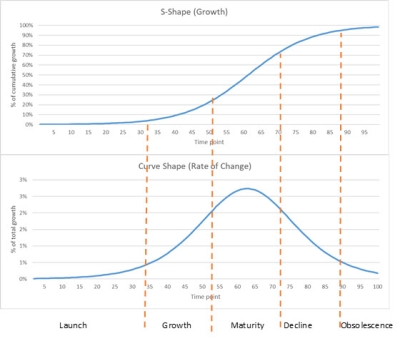Non-linear life cycle models
Non-linear algorithms are fitted to cumulative growth demand data (S-shape curve).
The stages of a typical non-linear life cycle include:
- Launch - The first stage in which the product is introduced into the market. This stage is characterized by slow increases in sales, which can be negligible. The Launch stage also indicates whether or the product will survive in the market and, thus, it is the most challenging stage. If the product survives, then the Growth stage starts.
- Growth - The stage during which the product is diffused into the market, with increasing sales.
- Maturity - The stage during which the product is well-established in the market. At the conclusion of this stage, the product’s sales begin to decline.
- Decline - The stage during which sales of the product dramatically decline.
- Obsolescence - The stage in which the product is replaced by another product.
The following graph depicts how different stages might be positioned in each non-linear modeling type:
Various analytical growth models have been developed. Coupa uses the following models to analyze growth:
- Bass - focuses on the effects of advertisers and customer ratings.
- Gompertz - focuses on product diffusion into the market and initial launch duration.
- Logistic - focuses on product diffusion into the market and initial launch duration.
- Modified Logistic - focuses on product diffusion into the market and expected initial demand.
- Monomolecular - focuses on expected initial demand and product diffusion into the market.
- Richards - focuses on product diffusion into the market and initial launch duration.
Last modified: Thursday December 19, 2024

